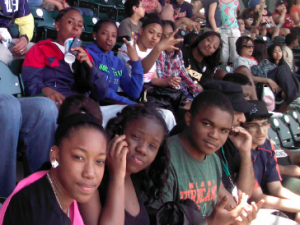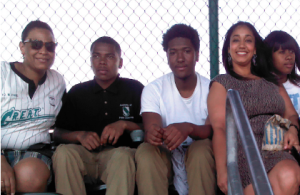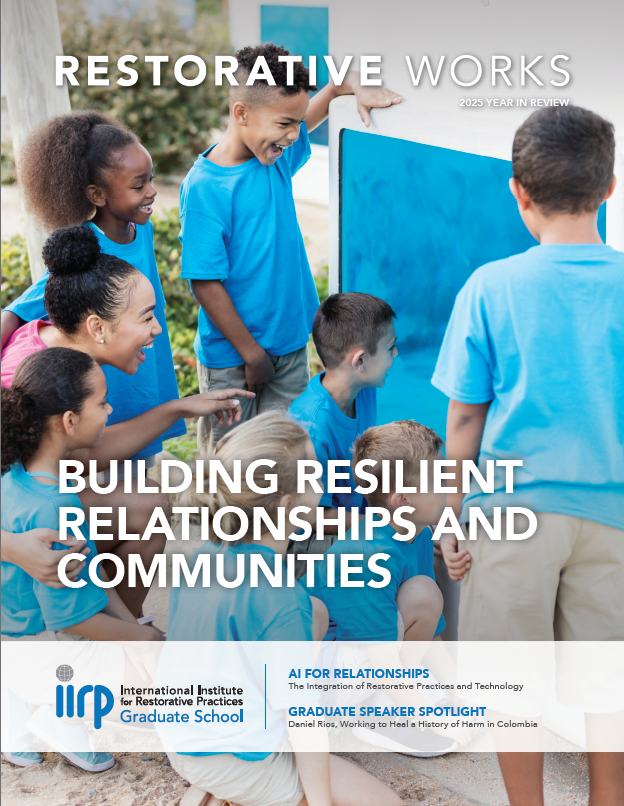You may download a PDF of this article for your personal use.
 Students at a Detroit Tigers baseball game.Detroit, Michigan, USA, can claim some of the highest rates of crime, violence, school expulsion, dropouts and truancy in the country. But as Henry McClendon, a pastor, program officer with the Skillman Foundation and IIRP licensed trainer and board member observed, “We don’t have a crime problem, we have a relationship problem.” To address this problem, McClendon aims to “infuse restorative practices in every major institution in the city, particularly those that touch kids, but adults as well: schools, social work, criminal justice, families and faith communities.”
Students at a Detroit Tigers baseball game.Detroit, Michigan, USA, can claim some of the highest rates of crime, violence, school expulsion, dropouts and truancy in the country. But as Henry McClendon, a pastor, program officer with the Skillman Foundation and IIRP licensed trainer and board member observed, “We don’t have a crime problem, we have a relationship problem.” To address this problem, McClendon aims to “infuse restorative practices in every major institution in the city, particularly those that touch kids, but adults as well: schools, social work, criminal justice, families and faith communities.”
Recognizing that this goal needed an established organization within the city to “carry the ball,” he brought the idea to Alice Thompson, CEO of the influential Detroit nonprofit social services agency Black Family Development, Inc. (BFDI). Thompson immediately saw restorative practices’ potential, and BFDI became an affiliate of the IIRP, licensed to train other organizations.
“We don’t listen to young people — we preach to them.”
“I was so dissatisfied with the lack of actions to keep young people engaged,” says Thompson. “We used a lot of power and control. We don’t listen to young people — we preach to them. We forgot: We didn’t like that as kids, either!” In restorative practices, Thompson says she has found “value-laden concepts with ways to use them and be clear about it.” Adds BFDI’s restorative practices program supervisor Manja Boyce, “Restorative practices repair relationships even during the training. New dynamics are built right there.”
What Detroit can gain from restorative practices, says Boyce, is an alternative way of communicating, instead of violence. “Because of the mobility of so many of our citizens, community breaks down. Everybody seems so detached. People go inside and shut their doors. BFDI’s goal is to strengthen relationships and build new ones in communities, so people will learn to communicate and interact better and take relationships seriously. We hope this can reconnect the city.”
Thompson is exploring tactics from changing school discipline policies at the state level — “putting sanctions on administrators who overuse zero-tolerance” — to seeking federal support. At a recent meeting in Detroit of U.S. federal officials, including Attorney General Eric Holder, Thompson brought up restorative practices, as “strategies to improve public safety by engaging community to develop relationships.” Holder nodded in agreement, said Thompson, who vows to “keep after him until we get federal dollars for restorative practices in Detroit!”
BFDI, the Skillman Foundation, the Michigan branch of the ACLU and other organizations are intent on making Detroit a restorative practices city. More than 3,000 people have been trained in the practices, and BFDI can barely keep up with the training requests from educators, social service and criminal justice professionals.
There are many initiatives in progress in the city. To name two: At YMCA of Metropolitan Detroit, led by Latitia McCree, vice president of Youth Development, Arts and Community Initiatives, restorative practices are helping kids in after-school programs and at a new high school, supported by Skillman, with training by BFDI. At the Detroit division of the national Inside Out Prison Exchange Program, spearheaded by University of Michigan Dearborn sociology professor Dr. Lora Lempert, the men of Macomb Correctional Center are learning to address issues and build relationships through restorative practices. We hope to share more about these and other area programs in future articles. You can learn more about Detroit’s restorative practices initiatives by watching “Progress on the Road to Restore the Motor City,” a video of Henry McClendon’s presentation at the 16th IIRP World Conference, October 2013.
This article focuses on hopeful stories from Detroit’s Cody High School and explores the questions that drive Restorative Works: “What works, what doesn’t, how and why?” with respect to restorative practices.
“We started talking about our lives.”
At Cody, which is made up of several small “academies,” police action and a “Scared Straight” intervention did nothing to resolve conflicts leading to a serious gang fight involving more than 50 students.
 Community Police Officer Monica Evans, Detroit Police Department, and students from Cody High School.Community Police Officer Monica Evans, a licensed IIRP trainer, began holding “proactive circles” with some of the school’s most disruptive students from two of its academies, APL [Academy of Public Leadership] and MCH [Academy of Medicine and Community Health] under the auspices of the program “Operation Safe Passage.”
Community Police Officer Monica Evans, Detroit Police Department, and students from Cody High School.Community Police Officer Monica Evans, a licensed IIRP trainer, began holding “proactive circles” with some of the school’s most disruptive students from two of its academies, APL [Academy of Public Leadership] and MCH [Academy of Medicine and Community Health] under the auspices of the program “Operation Safe Passage.”
The students’ first reaction to meeting in these groups was, “I’m not talking to no ‘m-effing’ police officer” says Evans, but as soon as she opened up and began to share her own story of hard times growing up — modeling restorative practices for the kids — they were hooked.
The groups met weekly for several months, sharing confidences, setting goals and making plans for the future. Among these kids, school attendance increased, grades improved and disciplinary problems and fights plummeted.
The positive results trickled down to the rest of the school, says Evans, because the kids in the groups became restorative leaders, modeling the practices for other students.
Rolonda Williams had been one of the most confrontational and defiant in the group. The daughter of a drug dealer, she regarded authority figures, police especially, as the enemy.
But the relationship she built with Evans in the circles affected her so deeply that Rolonda began “shadowing” her as she performs her job as a community police officer. Now 19, Rolonda plans to become a police officer herself.
Williams talked about how the circles changed things for her and the other girls: “We were always in trouble. We kept getting in fights; we weren’t doing our work. We didn’t believe in ourselves because nobody believed in us.”
But in the circles, she says, “We started talking about our lives. Officer Evans said we could make something of ourselves. She never ignored us and always listened to what we had to say.”
The circles helped the girls’ relationships with each other, too, ending years of fighting. Says Williams, “Before we were talking in the circles, we didn’t get along at all. When everybody told their stories, we heard that they were going through stuff at home. That’s why they had an attitude. We got where they were coming from. We sat down and talked, and now we’re really cool with each other.”
Continues Williams, “It really helped me because I had a bad attitude. I didn’t care about nothing. I was self-centered. I stopped being that way. My grades started getting better: As and Bs. I kept my grades up, graduated and turned my life around.”
About her future, Williams says, “I want to take pride. I want to experience everything: be a detective, work in a correctional facility, be a parole officer. I want to help the community and keep people out of trouble.” As soon as she passes her driver’s test, she will enroll in the police academy.
Another circle participant, Brigitte Murray, a former gang leader, had the idea to use her new restorative leadership skills to open a “recycling center” to help kids with their problems. Although often homeless, as a result of the circles, Brigitte never missed school, earned academic honors and led her school basketball team to a state championship.
Evans explains how and why these circles work: “It has to do with my transparency and vulnerability, which allow a door to be opened. When I talk about my early life, the kids see it was a lot like theirs.”
If a student disrupts a circle, this is an opportunity to model behavior, says Evans. She will apologize, without sarcasm, as if she were the one interrupting: “I’m sorry if I offended you. Did you have something to share?” At first kids don’t know what to do with this, but then they start sharing.
As the circles progress, she says, “I use my own parenting as an example. I talk about how my daughter is getting on my nerves.” The students give her support and ideas about how to handle her issues. “They help me, and the fact that they’re helping me helps them. I give them respect.”
“What a way to change a school,” says Evans. “Showing kids respect. I tell them, ‘You can teach the adults how to behave. You can make them wrong by succeeding. You’re winning by making them wrong about not believing in you. That’s real rebellion.”
Evans uses restorative questions in the circles, and the way kids respond to the questions evolves. At first, the response to the first restorative question, “What happened?” is to blame others. “Somebody did something to me.” Evans models appropriate behavior by responding to the questions herself.
|
Where I'm From I am from great tall humans - By Brigitte Murray |
In the circles, the kids address all the restorative questions: “What were you thinking about at the time [of an incident of misbehavior]?” “What have you thought about since?” “What do you need to do to make things right?” In addressing these questions, the kids make a commitment to behave better and work out a plan for their future. They write down all their responses, so they can refer to them and follow their plans.
“It wasn’t perfect, but they started to care about me.”
Pamela Rhea, a teacher at MCH, works with classes of kids with troubled behavior “so it doesn’t interfere with other students’ learning.” Last year, one class of 14 girls included Rolonda Williams.
Rhea holds all her classes in a circle and always sits in the circle with her students. They all share their stories, building relationships and helping each other. Every day starts with students writing down how they’re feeling, reading aloud what they’ve written and discussing any issues that come up. This gives them the opportunity to give feedback and advice, says Rhea, providing this example:
“I think I could be getting suspended.”
“Why?”
“Because I was fighting in the park and patrol took a picture.”
“Why were you fighting?”
“Because if I don’t the other kids will think I’m a punk.”
“You’re not a punk! You don’t have to fight!”
Rhea employs affective statements, telling her students how she feels about their behavior, which humanizes her and builds relationships. When she began teaching the group that included Williams, they were angry because they wanted to stay with their friends in other classes. “They called me horrible names,” she says.
Instead of yelling, Rhea told them, “I’m a single mother, and I have to come here to support my family. If you were in my situation, how would you feel?
“At first I got the mouth: ‘I would kick your butt.’ ‘I wouldn’t care — I’d just come and get a pay check.’
“I told them, ‘I could do that, but when I decided on this career as a teacher, I chose the underdog schools. I could have gone elsewhere, but I chose to come here. But I didn’t expect to be mistreated. I came to teach, but did you come to learn?’
“They all just sat and looked at me. That was the breaking point. It wasn’t perfect, but they started to care about me.”
Says Rhea, “It became their classroom. If someone moved the chairs out of a circle, they moved them right back. We did all the classroom activities in a circle: algebra, statistics.”
The students who had been sent to Rhea’s class so they wouldn’t “interfere with other students’ learning” began to excel. Rhea made each of them apply to at least five community colleges. Now they’re all attending, through grants and scholarships.
“I know people are listening and are here to help me."
Thrilled with the restorative practices training she received from BFDI, Marjani Jackson, MCH school service assistant and student council advisor, says, “We learned never to ask, ‘why?’ but to ask, ‘what’s going on?’ I’m using affective statements to tell kids how their behavior is affecting me, their teachers, their mom.” When there is an incident between students or if they are about to fight, the students take charge and organize a circle instead.
Jackson says that some students participate in the trainings along with staff and get a great deal out of it. “The students are surprised to learn how much the adults care about them,” she says.
Johnea Neeley, 15 years old when she participated in a restorative practices training at MCH in April 2013, says, “I used to think you had to be mean to be popular. Now I know that’s not true. You can talk to people and tell them how you feel. We sit down in a circle or a fishbowl — where two people say how they feel and talk it out. Then they shake hands, and the problem is over.”
Neeley says restorative practices are bringing a whole new culture to her school: “It helps kids not be violent. I know people are listening and are here to help me. We did a survey and 99 percent said that people are willing to listen.” And, she says, the practices could help Detroit as a whole. “It could stop a lot of violence and murder in the streets: fewer murders and suicides. This is what people need.”
A bright future for Detroit.
This school year, Evans is holding circles with more groups of kids at Cody, and now she’s including school security guards with the students. “At first the guards didn’t want to participate,” says Evans. But now everyone is beginning to communicate, sharing how each other’s actions make them feel. Relationships are improving all around.
In December 2013, Evans is helping launch a coordinated effort to continue to improve safety in Detroit. With a number of Detroit police officers trained in restorative practices, Mobile Neighborhood Community Officers will be assigned to Neighborhood Policing Units (NPUs) — area divisions within each neighborhood — “to provide the citizens with a direct connect and to foster relationships between the two,” reads a letter to community partners. The second piece of the effort involves CITI (Crisis in Trauma Intervention) Camps, to serve students within the schools who “need the most investment…” and “allow officers to engage directly with youth, providing life skills, conflict resolution … and family engagement.”
If dedicated leaders like Henry McClendon, Alice Thompson, Monica Evans, Manja Boyce and others who are committed to restorative practices have their way, the future of Detroit will be bright indeed.
About the Author
 Laura Mirsky is assistant director for communications at the IIRP, where she has worked since 2002. Her articles on restorative practices have appeared in Educational Leadership, The Prevention Researcher, School Nurse News, Principal Leadership, the Journal for Peace and Justice Studies and other publications.
Laura Mirsky is assistant director for communications at the IIRP, where she has worked since 2002. Her articles on restorative practices have appeared in Educational Leadership, The Prevention Researcher, School Nurse News, Principal Leadership, the Journal for Peace and Justice Studies and other publications.
Reprint Permissions
To request permission to reprint, please contact the
